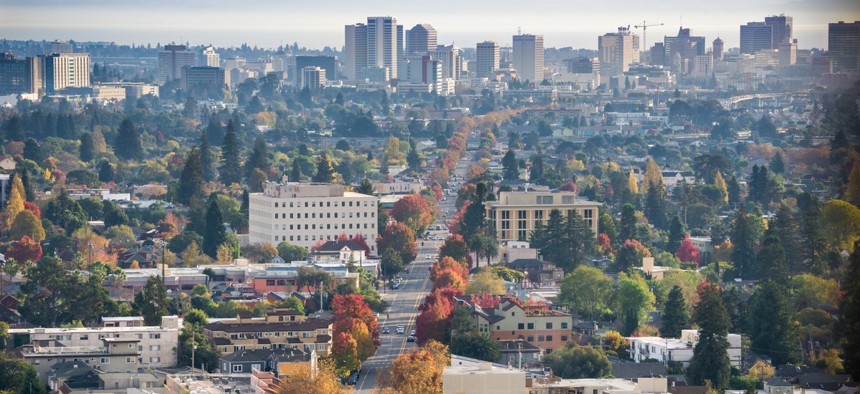Childhood Asthma: A Lingering Effect of Redlining

Aerial view of north Oakland on a sunny autumn evening. Sundry Photography/Shutterstock
New research shows that disparities in housing contribute to disparities in one of the most common chronic diseases afflicting children.
In the 1930s, a New Deal agency produced notorious maps to signal the credit worthiness of neighborhoods for mortgage lenders looking to refinance homes. These redlining maps color-coded predominantly African American neighborhoods as “hazardous,” indicating a high credit risk. Decades later, the “hazardous” warnings appear to be literally true.
A new study finds that people who live in historically redlined neighborhoods are more than twice as likely as others to go to the emergency room for asthma. The new research from the University of California, Berkeley, and the University of California, San Francisco, links decades of residential segregation to new findings of environmental racism. Disparities in housing contribute to disparities in the morbidity of asthma—one of the most common chronic diseases afflicting children.
The study examined historic redlining maps produced by the government-sponsored Home Owners’ Loan Corporation for eight cities in California (San Francisco, San Jose, Oakland, Sacramento, Stockton, Fresno, Los Angeles, and San Diego). Researchers led by Anthony Nardone, a medical student from the universities’ Joint Medical Program, compared the risk ratings with the number of emergency room visits for asthma for corresponding census tracts. Residents of redlined “high-risk” neighborhoods were 2.4 times more likely to go to the ER for asthma than residents of green “low-risk” areas.

Historically redlined neighborhoods also exhibited much higher amounts of diesel particulate matter in the air, according to the study. The researchers compared air quality ratings for each census tract in these eight California cities using a state data mapping tool.
Last year, the researchers at the U.S. Environmental Protection Agency’s National Center for Environmental Assessment concluded that people of color are far more likely to breathe polluted air than their white counterparts. Majority-black neighborhoods are more likely to be located near sources of pollution, according to a study that examined living patterns at “national, state, and county scales.”
Racial segregation is linked to disparities in education, safety, and wealth. The persistence of these effects over many decades—the Fair Housing Act banning discrimination in lending was passed more than 50 years ago—leads to generational gaps in outcomes.
But this new research shows that segregation means more than opportunities deferred or denied. Environmental racism is a present danger for communities of color. As a chronic disease that affects more children than adults, asthma is an especially pernicious symptom of racial segregation—a threat to health and wellbeing, but also an impediment to growth, education, and development.
Kriston Capps is a staff writer for CityLab covering housing, architecture, and politics.
NEXT STORY: Nation’s First Opioid Trial Promises Long Odds, High Drama





